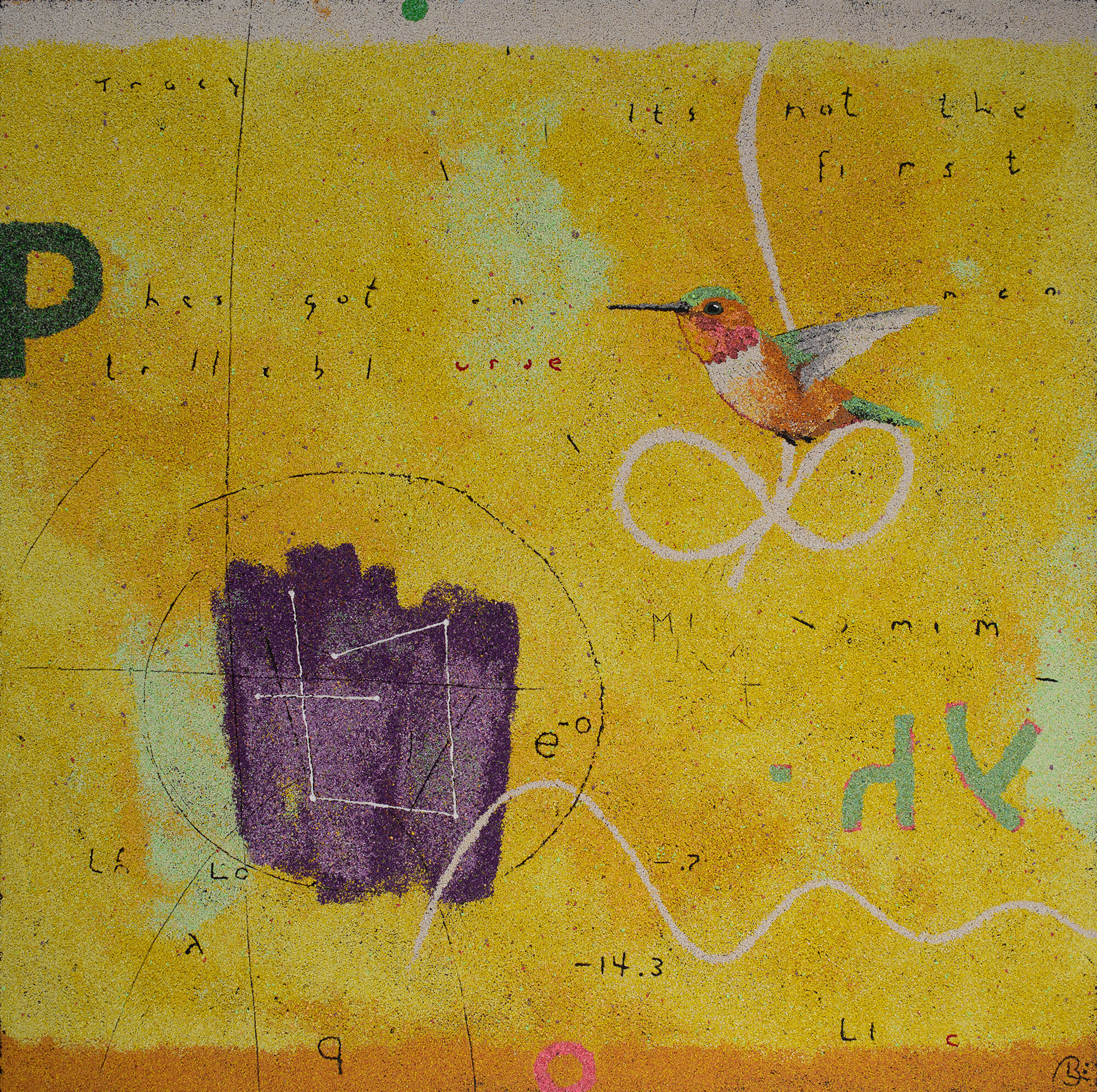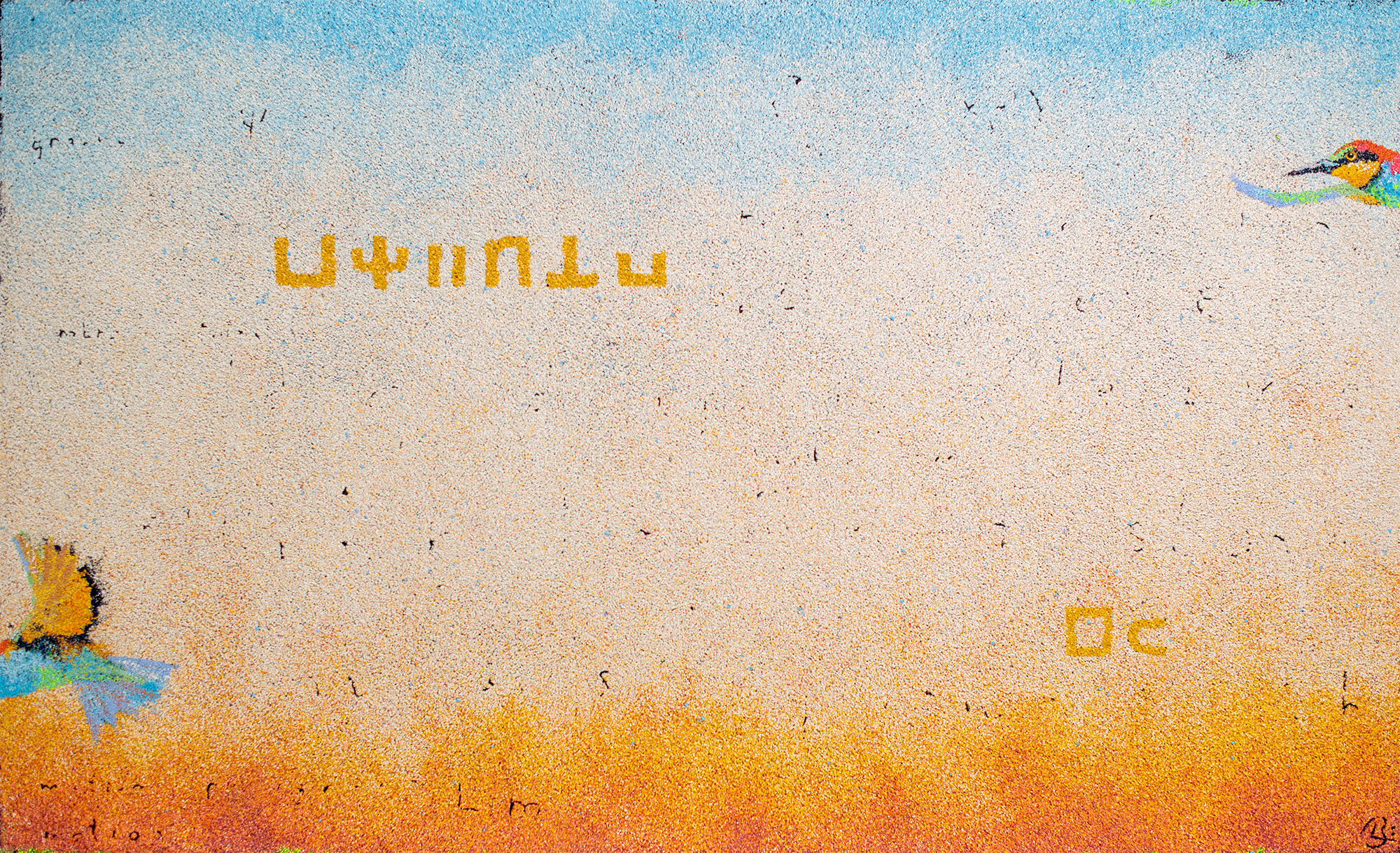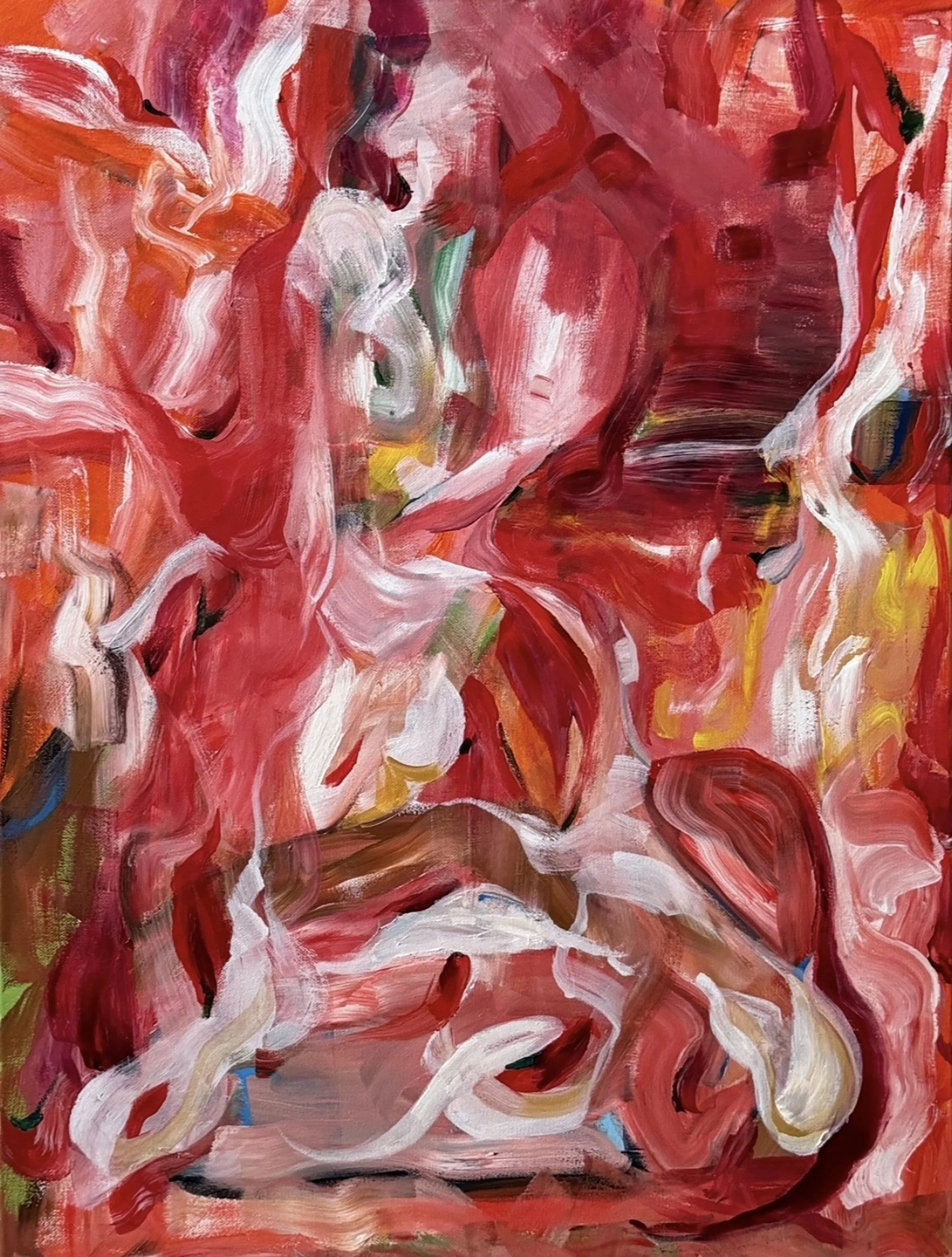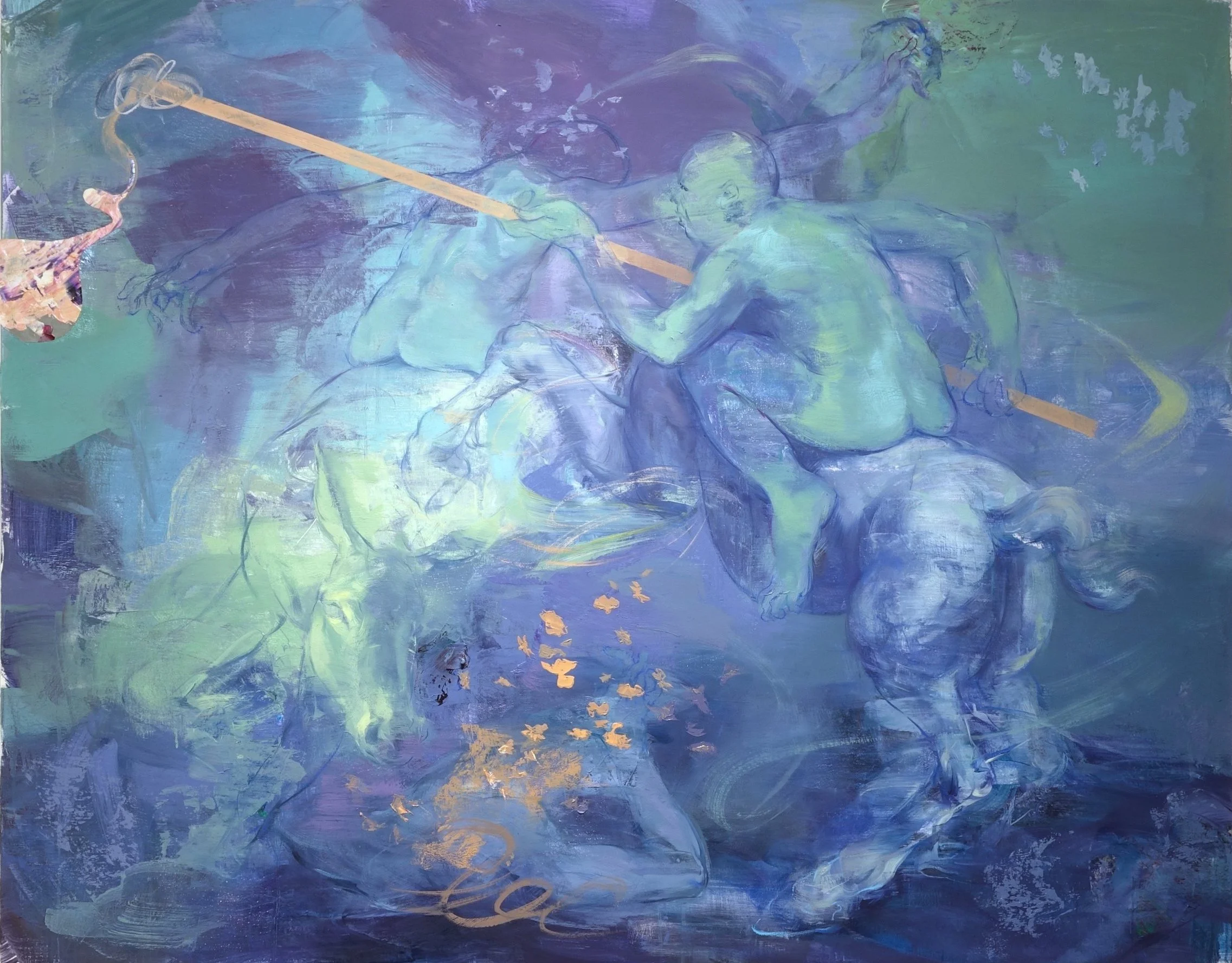10 Questions with Bob Landström
Bob Landström is an artist who primarily works with crushed, pigmented volcanic rock. His abstract paintings, with their highly granulated texture and color combinations, only achieved through such a medium, reconsider our relationship with “primitive” art by elevating the iconography of ancient languages, science, religions, and mysticism.
Born in McKeesport, Pennsylvania, Landström studied fine art by invitation at Carnegie-Mellon University. He later continued his fine art education at the School of Fine Arts Museum at Tufts University in Boston, Massachusetts. Landström also earned a Bachelor and Master of Science Degree in Electrical Engineering.
Landström’s work has been exhibited extensively and can be found in public, private, and corporate collections worldwide. He is the winner of the 1993 SOHO International Competition in New York, the 1994 and 2002 Open Studios National Competition, and other awards. When not in the studio, Landström spends considerable time abroad and has visited archeological sites across the world, which inform his studies and artistic practice.
Landström currently lives and works in Atlanta, Georgia, United States of America.
Bob Landström portrait
ARTIST STATEMENT
As the main medium of his paintings—crushed volcanic rock—is derived from the core of our planet, Bob Landstrom’s body of work is also an attempt to tap into the core of the human experience.
Landstrom believes we have more similarities than differences. Surveying human history, specifically through art, makes it clear that all cultures share a collective understanding of meaning and symbols, which might even be called a collective soul. By using the iconography of ancient languages, religions, science, and mysticism, Landstrom hopes to not only reconsider our relationship with the so-called “primitive” but also our relationship with the universal.
Landstrom’s work is fixed in this central principle, in the reservoir that all experiences and realities drink from and from which his paintings flow in a stream of consciousness. In many ways, these paintings visualize his thoughts and transceivers for the esoteric knowledge that he’s exploring.
This work is also about slowing down, offering dreamlike spaces where one is free to interpret, experience, and hopefully even break down the boundaries between familiarity and possibility. If anything, the work asks one to consider where we come from, where we are now, and how what we think can alter our own perceptions.
13363 kHz, Pigmented Volcanic Rock on Canvas, 72x48 in, 2019. Bob Landström©
INTERVIEW
What is your artistic background, and how did you start experimenting with images?
When I was a boy, I was invited to study fine art at Carnegie Institute in Pittsburgh, Pennsylvania. Following that, and still as a young man, I studied fine art at Carnegie-Mellon University. Later, I went back to study at the School of the Museum of Fine Art at Tufts University in Boston, Massachusetts.
The curriculum at Carnegie-Mellon was very classical. We’d spend what seemed like several lifetimes drawing bottles and human anatomy. It was an environment focused on developing the “craft” of being an artist and honing the connection between the eye and the hand.
The curriculum at the Museum School was completely different. In this environment, the focus was on the “why” of art. What is my role as an artist?
This contrast of artistic programs was good for me. One day at the Museum School, my advisors recommended that I explore my own path. That’s when I started to experiment with my own aesthetic, fueled by this notion of finding my role in the wild as an artist.
Why are you an artist, and when did you first become one?
I think I’m an artist because I have to be. Said another way, I’m compelled to do this. My brain is consumed with these concepts and images in a way that obsessively drives me to paint.
My first real gallery exhibit was in 1987, so you might say that was the start of my journey. I became much more prolific and commercially successful in the past five years. Many more people have become aware of my work since then.
She Gently Blew Up, Pigmented Volcanic Rock on Canvas, 48x48 in, 2020. Bob Landström©
Disbelieving Doer, Pigmented Volcanic Rock on Canvas, 48x48 in, 2020. Bob Landström©
Can you tell us about the process of creating your work? What is your artistic routine when working?
If someone created a graph of the physical activity of my creative process, you’d probably have a bell curve.
I start by doing a lot of thinking and deciding. I’ll sit in my garden for hours and stare at things. I’ll have some coffee, look at some sketches and notes that I’ve made, and stare some more. Once I’ve decided what I want to do, I dive into the painting. This part will be physically intense because I have to race against the curing time of my medium. Once it cures, it’s hard and doesn’t move. If it can’t move, I can’t paint. So it’s a bit of a race to get the painting to the point where I can allow it to cure. Once it’s mostly cured, I’ll work on some finishing touches. When a piece is finished, I’ll sit in the garden again and toast the new piece with a celebratory drink.
There is a lot more process involved in my work than I care to admit.
Because I paint with the Earth itself, I have first to create my materials. This is a process of applying pigment to pulverized rock that is quite involved. Some days are entirely spent doing this, just preparing the materials. If you look around my studio, you’ll see dozens and dozens of bins filled with different colors of pigmented rock. I have to have all this before I start a painting. So it’s either a rock-coloring day or a painting day. Seldom do the two steps occur on the same day.
The actual painting itself involves a process too. The binder that I use to attach the rock to the canvas makes the colors look very pale and milky until they cure. As I work, I have to sort of look past the color I see and imagine the color that will eventually be once the material cures. It’s like watching a polaroid print develop, except that this happens over many hours rather than minutes. Once the material cures, it can’t be moved around. The painting tells me when it can’t go on any longer. I sometimes throw out several days’ worth of work because it didn’t cure the way I expected it to.
Occasionally I’ll want to do something new with the material that requires some different type of tool. I often appropriate shop tools or medical devices and alter them to use with my painting material.
Mogotrevo, Pigmented Volcanic Rock on Canvas, 48x60 in, 2021. Bob Landström©
In your work, you use crushed volcanic rock. Is there a meaning behind this material, and why did you choose it in the first place?
I painted with regular paint, liquid paint, for a long time. At one point, I thought that there was probably a better painting medium for me, something that was more closely aligned with the energy of my images.
I experimented with several different things in a haute pâte sort of context, but they mostly left me feeling empty.
After an expedition studying petroglyphs made by indigenous peoples in the American Southwest, I became inspired by the Earth element in particular. I thought that if I was able to paint with the Earth itself, this would really amplify the spiritual energy of my images. I’m an Earth sign myself, so that seemed to make sense, too.
Following that idea, I experimented with a number of Earth-based materials. The idea of using igneous rock seemed even better aligned with my purpose, given its alchemical qualities. Once the liquid in the belly of the Earth, it’s now solid in my hands.
For me, the metaphysical qualities of a material like this are very powerful.
Your artworks present a mix of symbols and mathematical formulas; what is the message behind this mixed language?
There are a few things at play there.
For one thing, I mostly choose these for their graphical qualities. I’ll even invent characters for that same reason. You’ll also find words, lyrics, formulae in the paintings. These are connected with the ideas I’m thinking about as I’m creating the painting. These phrases sometimes make it intact in the finished piece, and sometimes they become deleted by the action of the painting process.
Engineers, chemists, and such are excited to find things they recognize in the paintings.
I’ll often catch people trying to read my paintings. They sometimes ask what language it is. This is funny to me.
In the end, though, it’s less a question of message than it is a snapshot of a moment of my own contemplation of the subjects I work with.
Eureka Romp, Pigmented Volcanic rock on canvas, 48x48 in, 2020. Bob Landström©
Hoot Magnet, Pigmented Volcanic Rock on Canvas, 48x48 in, 2020. Bob Landström©
In your statement, you refer to a "collective soul" that can be found in symbols across different cultures. Can you provide us some examples?
If you look at what remains of ancient cultures, you'll find that they all have a graphical language. Think of the alphabet or emoticons and such in our own civilization. These all have a meaning of some kind, either individually or in context with one another.
If you look at these things from these very old cultures and compare one culture to another, you find striking similarities. For example, across, or a figure-eight shape or some more complex symbols show up in different cultures simultaneously in and across time. More interesting, they show up this way in cultures starkly separated geographically. Even more interesting, the same symbol carries a similar meeting across different cultures that seemingly had no way of physically interacting with one another. Now isn't that something? So the idea of a collective soul occurred to me like the transmission medium that connects these things across distance and time. It's evidence of a "human-ness" that makes us all the same no matter who we are or where we come from.
How much planning goes into each artwork?
I'm sort of afraid of the word "plan." I'm not sure why that is. It just feels like something my third chakra wants to shut out.
At any given time, I have a lot of painting concept sketches. Most of my sketching is now done on the iPad instead of paper sketchbooks. I'll add and subtract on a sketch, add new sketches on almost a daily basis. I constantly prioritize them into "top five" lists which are on deck to become paintings. There is some fluidity in that top five list.
There's the editing that goes into each of these sketches, and then the prioritization of the sketches among one another. Eventually, I'll pull one of them to be today's painting. Sometimes I'll do a painting from a sketch as soon as I've drawn it, or even start painting without any sketch at all. Sometimes a sketch will ride the list for months. Many have never become paintings.
I guess that when you get right down to it, sometimes there are months of planning and sometimes none at all. I'm not sure that it matters one way or the other. Sometimes planning can result in over-working a concept.
Gloria 4AM, Pigmented Volcanic Rock on Canvas, 60x36 in, 2021. Bob Landström©
What does your art aim to say to the viewers?
I hope that my work gives a viewer a place to detach, get lost, and dream. Some people are map-people. They can stare at a map for hours and become lost in their thoughts. I think my paintings are like that. With its textures, scratches, hills, and valleys, the surface is very contemplative (like a map). The symbols, formulae, and words offer rest stops along the way.
There’s no pressure to decode the painting or to “get it.” It’s a safe space to breathe and let go.
The most frequent comment I hear about my paintings from viewers is: “It just makes me feel good.” I couldn’t ask for a better compliment.
Do you find that the shift to digital exhibitions and art fairs has helped you promote your work?
The digitization of the gallery experience during the pandemic has not been extremely fruitful for me so far. The materiality of my work is a big part of the experience of looking at it, and this is difficult to replicate on an electronic display. Most of my commercial activity is still through the brick-and-mortar gallery experience.
Finally, any projects you are looking forward to for this year?
I’ve been reading a lot about string theory and parallel universes. That has largely informed much of the work I’ve done so far this year.
I’m also interested in the field of physics known as “biocentrism.” This is the notion of how, at the quantum level, reality behaves in a way that’s linked to the act of observation itself. Consciousness as a co-creator of physical reality. This whole idea is portended by metaphysics thousands of years ago. The whole idea is driving me crazy because it seems to devolve into solipsism. I’m trying to put it into the right place in my head. I’ll probably be weaving this into my work soon if it doesn’t drive me mad first.



























